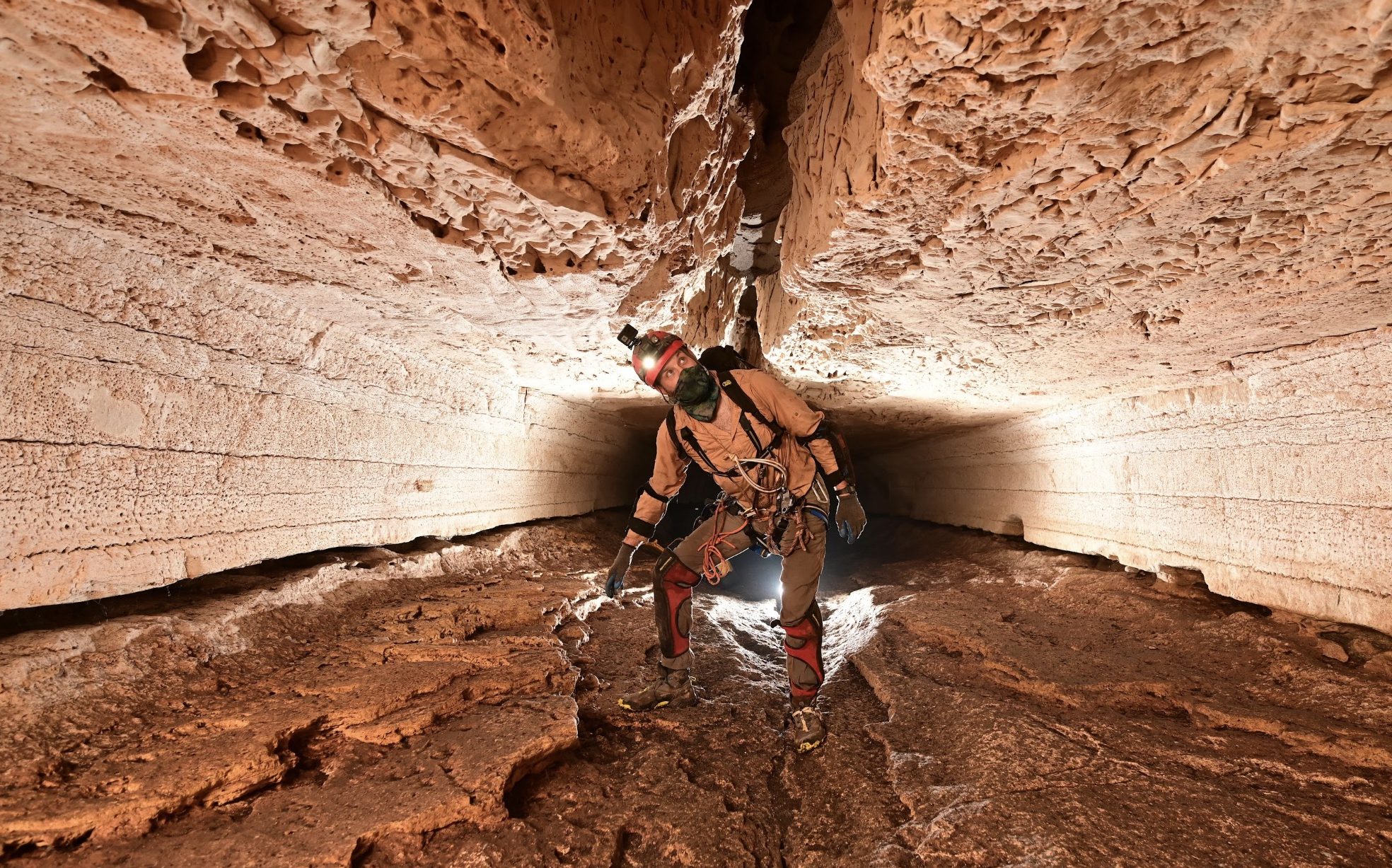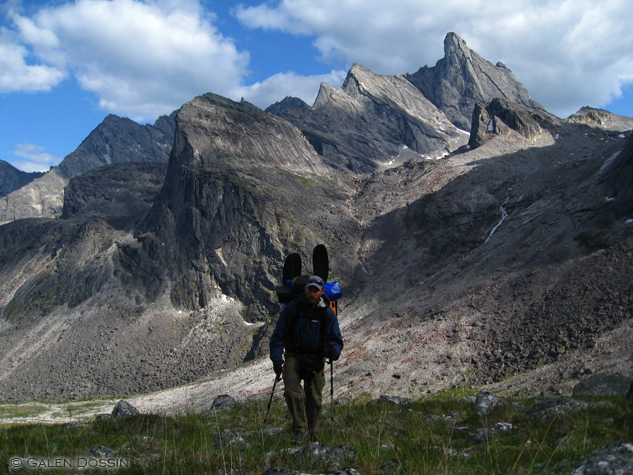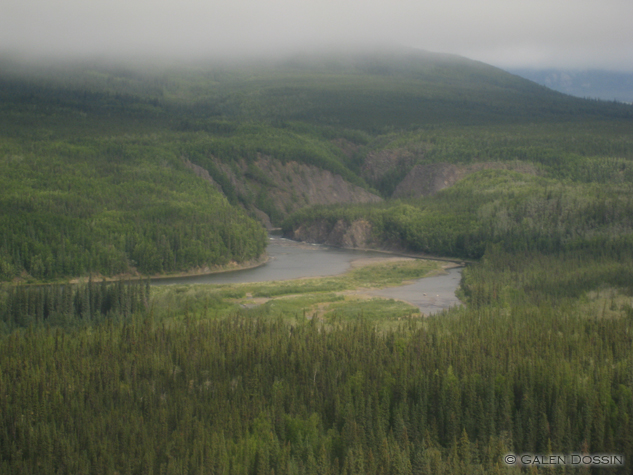Something hard smacked me in the spine and I jolted upright in the tent. Two feet from my head I heard the huffing of a very large animal and I instinctively yelled at the top of my lungs,
“HEEEY BEAR, HEEEEY BEAR, HEEEY BEAR!”
Galen started yelling as well. As a NOLS instructor, Galen has tons of Alaskan experience and has had many bear encounters- but never this close.
We couldn’t see the griz because we’d put the fly on the tent just an hour earlier, but we could hear the rapid breathing of a very excited animal just inches from the thin fabric.
This was a stare down I did not want to have.
We continued yelling but the bear lingered for an unsettling amount of time. We listened in horror as the brute veered away a few yards, then turned and charged the tent.
This was my fourth trip to Alaska’s Brooks Range and the first time I hadn’t brought a gun.
“WHERE’S THE BEAR SPRAY?!”
Galen reached down to the foot of the tent, found the spray, and promptly handed it to me, as if to say, “I ain’t going out there!” True, the spray inside the tent wasn’t going to help us much, unless we wanted to mace ourselves, but I unclipped the safety tab anyway because the idea of the beast ripping through the tent seemed like a very real possibility.
After a few heart-stopping seconds, the sounds of the bear ceased and I cautiously poked my head out of the tent while continuing to yell at the top of my lungs. Galen shouted, “Look!” as he pointed in the direction of two golden grizzlies, one big, one small. The sow and cub fled with purpose down the valley and out of view.
The experience left us numb. Our senses reeled with the after affects of the adrenaline dump. At the time, I thought it was the bear who’d hit me in the back, but after some discussion I realized it was more likely Galen accidentally hammerfisting me when he was rudely awakened by the sounds of the bear approaching.
We didn’t have any food in the tent and we followed all the bear country etiquette. We figured the grizzlies came over the hill and stumbled unexpectedly upon our big blue tent. The sow must have assumed it was a threat to her cub, and then charged.
I’d screamed so hard during the incident that I lost my voice, which left me feeling more than vulnerable. It was only day three of a 14 day trip and we were sure to see an abundance of bears. What was I going to do if we had another encounter? Clap? I can’t even whistle!
We were camped in the heart of the Arrigetch Peaks, an area known for its impressive collection of granite towers, minarets, and spires. The original inhabitants, the ancient Nunamiut Eskimos, called the mountains ‘Arigaruit’ which means ‘fingers of the hand extended’.
To access the Arrigetch we took a flight from Fairbanks to the remote bush community of Bettles- population 39. From there we took another 45 minute flight and landed on Takahula Lake situated in the center of a massive 8.5 million acre preserve known as the Gates of the Arctic National Park. The area is one of the most remote spots in North America and could best be described as ‘wilderness on crack’.
We’d scrambled over the high passes and around peaks with names like Battleship, Shot Tower, and Xanadu. The area, 60 miles above the Arctic Circle, was just as grand as Yosemite, minus the crowds and RV’s.
Two days later we hiked down into the tree zone and found ourselves at the bank of Awlinyak Creek. Typically, a backpacker approaches a creek like this one and views it as a hindrance, an obstacle to be crossed or hiked around but Galen and I looked at it with smiles on our faces. We rummaged through our packs and pulled out two 5 pound rafts. We’d read a trip report stating the creek was about knee-deep which is perfect for a packraft. The Awlinyak was crystal clear, a little shallow, but a lot of fun. The current moved us quickly down valley through little wave trains and miniature canyons. We had to be careful because we had no idea what lay ahead but it was thrilling to see the miles fly by after the long hike with heavy packs the days before. Grayling, those iridescent beauties, swam in deep pools beneath us. Occasionally they kissed the surface of the water, teased us, and spelled fresh food across our thoughts. They wouldn’t know about our lures and would be easy to catch but we were more interested in making miles that day than we were eating fish.
 There is a very good possibility that we were the first people to descend that creek, not that anyone else would care, but we felt the pang of pride regardless and ‘high-fived’ our way down valley to the confluence of the Alatna River.
There is a very good possibility that we were the first people to descend that creek, not that anyone else would care, but we felt the pang of pride regardless and ‘high-fived’ our way down valley to the confluence of the Alatna River.
That night a very big, very curious wolf came into camp. It walked up unafraid, almost like a dog would when seeing its master. I ran at the wolf thinking this might change his mind but it didn’t, and I soon stopped in my tracks.
“He almost seems friendly”, I said
Galen grabbed the bear-spray and responded, “Yea, but I don’t want to play that game.”
The wolf circled. I kept looking over my shoulder wondering if his pack was watching from the woods beyond. But the overgrown canine seemed to be alone and very interested in our tent. Unsure of what to do, the apex predator decided to sit down and watch us.
I’d always wanted to see a wolf like that, so dangerously close. When my dreams met reality, however, I realized with certainty that there was no way in hell I was going to sleep with that big-ass wolf outside the tent.
Galen and I picked up a handful of rocks and ran at the wolf like banshees. We had no intention of hurting Canis Lupus, we just wanted to scare him enough to leave, which he eventually did.
 We’d completed a big 7 day loop and arrived back where we’d started at Takahula Lake. We had decided to break the 14 day trek into two, seven day trips. That way we were able to cache some food in bear barrels at the lake, enabling us to travel with lighter packs and a few extra luxuries like white gas and whiskey.
We’d completed a big 7 day loop and arrived back where we’d started at Takahula Lake. We had decided to break the 14 day trek into two, seven day trips. That way we were able to cache some food in bear barrels at the lake, enabling us to travel with lighter packs and a few extra luxuries like white gas and whiskey.
We then aimed our sights on the headwaters of the Kobuk River, a frontier that goes years without seeing a single visitor due to its lack of places to land a plane. After two days of hard travel, we arrived at the area we would start referring to as the ‘Animal Kingdom’ due to the amount of bears and wolves calling the valley home.
We intended to use our packrafts to escape the wilderness in a timely fashion. However, wild places tend to have their own ideas of when you will and when you will not be leaving. We heard the distant roar of the river ahead and knew instantly that we were going to have to portage.
Thankfully, the bear trails were magnificent; in fact, I’d call them bear highways. Bear tracks and scat led the way. Occasionally we’d see territorial markings where a bear had torn off all the limbs and bark from a tree and then rubbed his back against the oozing sap, leaving a thick coating of hair permanently embedded in the tree. I pulled some hair off the sap and gave it a smell. I expected the stink of a dirty animal but was rather surprised by a pleasant leathery smell, that of an old shoe store.
The bear trails and the subsequent lack of brush made the portage easygoing although the sounds of the rapids muffled any conversation we might have had. Periodically, the roar of the river was almost deafening which drew our interest as we assumed there might be a large waterfall nearby. There were at least a couple miles of continuous class 4 and 5 rapids but we never saw anything we considered unrunnable. However, it was beyond our skills as packrafters. We referred to this section of the river as Kobuk Falls and vowed to be back when our skills improved. Gradually the rapids decreased to riffles and we jumped back in our rafts, happy to be floating once again.
Below Kichiakaka Creek there was another splashy, boulder-dodging rapid that we scouted and ran. On a cliff overhanging the river, a small colony of swallows made an impressive array of clay nests that resembled upside-down tea kettles. I’d visited this area once before, over a decade ago, and I remembered those birds and their homes. Although it seemed crazy, I wondered if anyone had seen them since.
That’s the greatest thing about visiting the Brooks Range- besides seeing the granite peaks, the wildlife, or the crystal clear waters. It’s those moments of discovery. Had we found ourselves in one of those rare places in the world where no one else had ever been??? In the Brooks Range, there is always that distinct possibility.*
Making our way up Aiyagomahala Creek. Shot Tower in the background. There are some natural hotsprings in the valley but if you visit in the summer the area is infested with mosquitos.
Xanadu, Half-Dome of the Arctic!
Kobuk side of Independence Pass
Climbing to Deception Pass, Melting Tower in background.
Rainy days on the portage to Kobuk Headwaters
Upper Kobuk Canyon. There was supposed to be some rapids here but we didn’t find any. I’ve done this section in an open canoe.
Lower Kobuk Canyon however did have some fun rapids. It’s a beautiful place. The canyon itself is a natural barrier, it keeps all the hunters from the village of Kobuk from making their way up with motor-boats beyond this point.
Historic Bettles Lodge











Not sure if anybody monitors this page but I’d love to get some beta on Awlinyak Creek. No one seems to have any… I will be pack rafting up there in a few weeks.
Hi, Hunter. What’s yer question? I’ll try to email you directly.
Hey Dave thanks for the post! Are you willing to share your email so I can ask a couple questions?